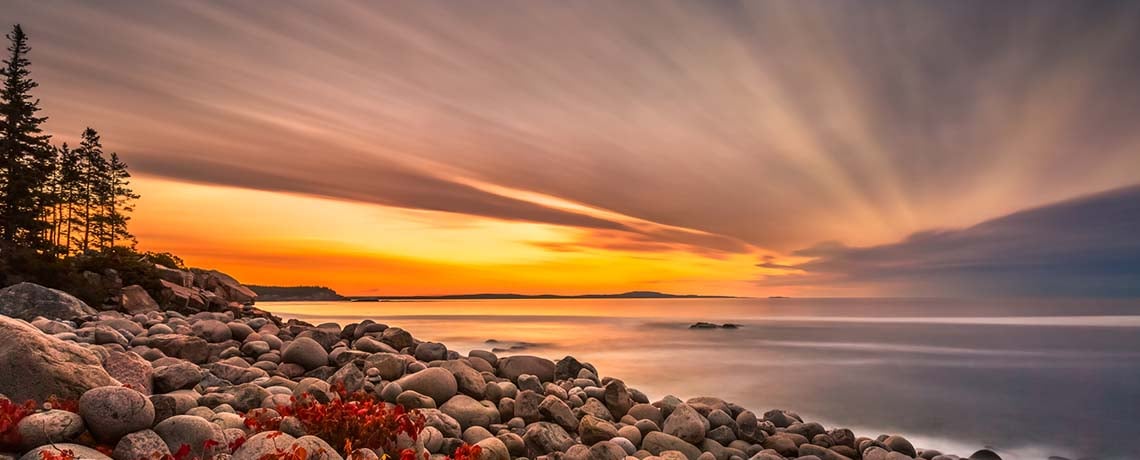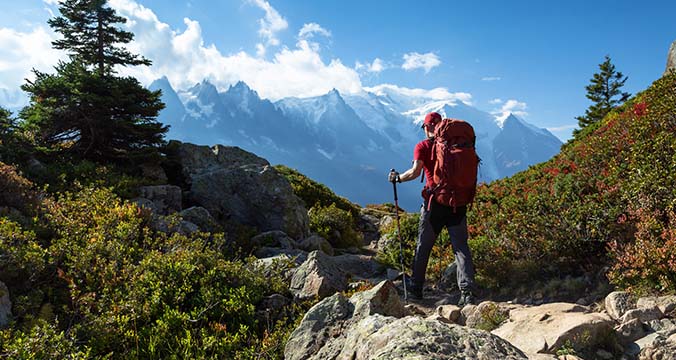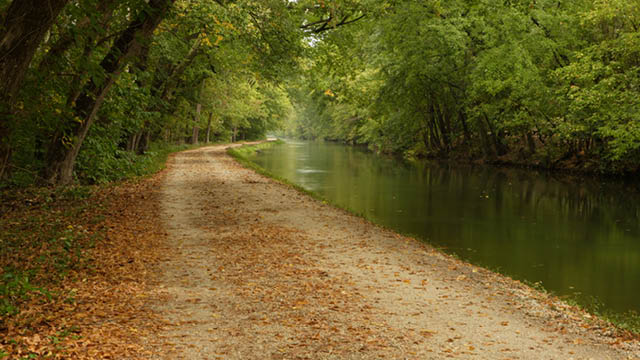Discover Our Favorite Active Vacations
For travelers who like to stay active, there’s no better vacation than one that combines immersion in a new destination with participation in a favorite activity


My friend Cheryl and I have come to southern West Virginia to raft the Upper Gauley River during the fall dam-release period known as Gauley Season, one of whitewater rafting’s epic adventures. It’s a heart-pumping day of paddling, getting drenched by the cold October waters as we run the 37 named rapids—including 5 supercharged Class V+ rapids—on this boulder-strewn river that courses through a 500-foot-deep gorge in the wilds of the Gauley River National Recreation Area.
This excursion with Adventures on the Gorge is about the thrill of the whitewater, but it’s more than that. It’s about experiencing this wild and scenic region of the country; it’s about meeting other rafters who’ve come from near and far; and it’s about refreshing ourselves mentally and physically through immersion in nature.
There are plenty of travelers like me who want to step out of the tour bus and commune with an area’s natural environment. A whitewater rafting or kayaking trip is one way to do that, but you needn’t put on a wetsuit and a life jacket to experience a new destination. Other active travelers find great pleasure in walking natural and cultural trails or cycling country roads and rail-trails. We consulted experts on where to enjoy these activities, whether you’re a novice or an old hand.

WHITEWATER WANDERINGS
Since we’re already in a paddling mood, let’s start with some suggestions for where to find great whitewater in surroundings that range from scenic to drop-dead gorgeous. Our expert is Mark Singleton, executive director of American Whitewater, a nonprofit group advocating stewardship of our country’s whitewater rivers.
Note that whitewater rivers are rated from Class I, being the easiest, to Class V, which have the most challenging rapids and are usually in remote settings. Whitewater season typically runs from May through September, although that’s extended in warmer climes. A day of paddling typically means six hours on the water, with breaks for meals. Multiday trips would include camp tenting on the riverbanks, with the outfitter providing equipment, meals and camp setup.
BEGINNER
Nantahala River, North Carolina
Class II, with one Class III rapids at the bottom
“The Nantahala is more of a mountain stream than a river, but it’s beautiful. It flows through the Smokies. It’s got consistent water through the summer, and the water quality is really high. It’s just a comfortable introductory experience, and it’s great for families looking to engage their younger children in some kind of outdoor activity,” according to Singleton.
Rogue River, Oregon
Class III
“The section of the river that I recommend is from Grave Creek down to Foster Bar, a pretty four-day trip. You’ll be traveling through a fairly rugged mountain range that has incredibly diverse flora and fauna. You’ll see eagles and osprey and deer and sometimes black bears. There’s interesting history because the river was historically used for gold mining operations. So there’s an opportunity to see both the human interaction with the river over time and the natural flora and fauna of the river corridor itself,” Singleton says.
ADVANCED
Upper Youghiogheny River, Maryland
Class IV and V
“The Upper Yough (pronounced Yawk) is a tight, technical river. You’re maneuvering around rocks quite a bit more, and there’s more precise paddling involved with twists and turns as you navigate the rapids. It’s just this beautiful kind of boulder garden that’s strewn out through a fairly isolated river canyon in Western Maryland that’s super pristine. For advanced whitewater kayakers, it’s a destination run, just like the Upper Gauley,” Singleton says.
Selway River, Idaho
Class III and IV
“The Selway is the quintessential Idaho River: remote and drop-dead gorgeous. Commercial outfitters usually do it in four days. It has beautiful rapids, great fishing and campsites that are right out of a fairy tale. You whip around a corner on the river, and there’s this big peninsula sticking out from the bank that creates a big eddy, and there’s a sand beach. It’s a really special experience. It’s also a tightly regulated river so that only one party [usually a commercial group with five or six raft loads of people] can launch per day. So your experience on the river is going to feel pretty remote, with your group the only people you’ll encounter on a given day,” says Singleton.

Safety Tip
Unless you’re a highly experienced paddler familiar with the river, go with an established rafting company that earns good reviews from former trip-goers. If you’re experienced but are bringing family or friends along who are less experienced, for safety’s sake, go with the pros.
AMBLING THROUGH THE COUNTRYSIDE
Whether you call it hiking, trekking or plain old walking, touring a region on foot is the all-time classic way to get to know a new destination. We consulted Robert and Martha Manning, authors of Walking Distance: Extraordinary Hikes for Ordinary People and Walks of a Lifetime: Extraordinary Hikes from Around the World.
People come back from their first walking vacation, Martha Manning says, and “they’re completely captivated by the way you can sense the environment through which you pass, the way you absorb the history and beauty of the region and enjoy the friendly local folks you meet. It’s a really immersive experience when you walk through a landscape.”
BEGINNER
Carriage Roads in Acadia National Park, Maine
57 miles, 44 of which are in the national park
Stay in a nearby town—Bar Harbor, Seal Harbor or Northeast Harbor—and drive (or better yet, take the free Island Explorer shuttle) to each day’s starting point, walking as many miles a day as you desire.
“There’s a fabulous system of carriage roads on the eastern side of Mount Desert Island that were built in the early 20th century at the direction of John D. Rockefeller, Jr., so that he and his peers could go out in their horses and carriages and not be disturbed by car traffic and noise. The carriage roads are wide, well graded and gently sloped, and they encompass many of the best views of the iconic features on the island. There are 17 distinctive footbridges designed by Italian stonemasons, along with two big gatehouses,” says Martha Manning, who recommends timing one of your walks to have tea at Jordon Pond House. (Be sure to make a reservation.)

Cinque Terre, Italy
Five seaside villages a short walk apart along a marked trail
Once remote, the towns of Cinque Terre are now served by train and ferries. Select a home base, and take the train to different starting points each day, returning in the evening to your lodging; or walk from town to town, staying at a different hotel each night.
“In addition to the trail that connects the five towns, there’s a very large network of trails up in the hills above the towns. The whole area of Cinque Terre is a UNESCO World Heritage Site. It’s just one of the world’s great, beautiful and culturally significant places. These five medieval fishing and agricultural towns still maintain vineyards and olive orchards on terraced slopes and colorful fleets of fishing boats—and all of these foods are available in local restaurants,” Robert Manning says.
INTERMEDIATE
Presidential Traverse Trail, New Hampshire
24.5 miles
Break this walk up into three days, overnighting at huts operated by the Appalachian Mountain Club. Breakfast and dinner are included, and reservations are necessary.
“The Presidential Traverse is one of the most iconic parts of the Appalachian Trail; it goes up and over some of the most scenic peaks in the dramatic White Mountains [seven named for U.S. presidents], including Mount Washington, the highest mountain in the Northeast. The walking can be challenging in places. The trail is well marked, but it’s steep and rough in some places,” Robert Manning notes.
Coast to Coast Walk, England
192 miles
Cross Northern England from the Irish Sea to the North Sea in about two weeks, or pick a section, perhaps covering one of the three regions punctuated by a national park: Lake District, Yorkshire Dales and North York Moors. Walk from town to town, staying at bed-and-breakfasts.
“The Lake District is probably the most celebrated landscape in England. It’s hilly with lots of lakes, and this is where Wordsworth lived and composed many of his great poems; it’s inspirational. In the middle of the country, you walk across the Yorkshire Dales National Park, a farming region, which is another spectacular part of England. And then, last, you walk through the North York Moors National Park, a stark landscape, which has a beauty of its own. And when you complete the walk, you really feel that you’ve gotten a sense of what it’s like in England—the history, culture and beauty of the place,” says Robert Manning.

Tour du Mont Blanc
110 miles
Among the most historical and popular walks in Europe, the TMB, as it’s known, is a walk around the base of 15,774-foot-high Mont Blanc, known as the “Monarch of the Alps.” The route passes through three countries: France, Italy and Switzerland. “You typically start each day in a valley, and you go up over a pass and down into another valley for the next night’s lodging,” Martha Manning says. Most walkers complete the trail in 11 days.
“You’re walking with this dramatic mountain at your shoulder with glaciers hanging onto the slopes, and it’s just so scenic and spectacular. It’s interesting to see how, when you’re in different countries, the character changes. For example, when you’re in Switzerland, everything is chalets and geraniums overflowing the balconies. You expect yodeling, and there are herds of cows with bells around their necks making music. France is a little less flowery, a little less exuberant. In France, you get to the town of Chamonix, one of the early mountaineering and skiing areas in the Alps. Italy is a little plainer, but the mountains are just as beautiful, and the town of Courmayeur is an important center of mountaineering,” Martha Manning says.
Safety Tip
Do your homework before you set out on the trail. Make sure you have the right equipment, including way-finding materials. Most of all, you need to know that you can walk 8 to 10 miles a day for however number of days it will take. If you’ll be walking at an altitude you’re unaccustomed to, acclimate for a few days before beginning your walking journey.
Gearing Up
Prepare for your walking vacation by walking more in your daily life and spending time on weekends walking in all kinds of weather. Buy lightweight multifunctional clothing, and break in everything before setting out on your trip, not just your shoes. Know how to use all your gear.
TWO-WHEELING IT
Cycling on rail-trails or moderately traveled roads can be a great way to see the country. AAA Traveler Worldwise spoke with Arlen Hall, tours director of the Adventure Cycling Association, a nonprofit that encourages people to travel by bicycle. The association also sells maps and gear and leads bicycle tours to fund its nonprofit work.

BEGINNER
C&O Canal Trail and the Great Allegheny Passage, Washington, D.C; Maryland; Pennsylvania
335 miles combined
This is a popular ride with bicycle tour companies and individuals. You can ride any segment (or all) of the two connecting trails. The first 185 miles—the C&O Canal portion from D.C. to Cumberland, Maryland—is a packed dirt rail-trail shared with walkers. It links to a gravel trail from Cumberland to Pittsburgh, Pennsylvania. Stay in campgrounds or bed-and-breakfasts along the way.
“This is one of my favorite trails for two reasons: it’s car-free, so I like the safety of that. The second reason is that it’s historically significant. George Washington surveyed the area for the canal; there’s Civil War history with Harpers Ferry and the Antietam Battlefield; and there’s also American Revolutionary War history in Fort Frederick, Maryland,” Hall says.
“The Great Allegheny Passage segment of the trail goes all the way to The Point in Pittsburgh, where the Monogahela and Youghiogheny Rivers come together to form the Ohio River. You end up riding along the river into Pittsburgh, and you can see the history of the steel industry there.”
Trail of the Coeur d’Alenes and Route of the Hiawatha, Idaho
88 miles combined
Figure on four days for riding the 73-mile Trail of the Coeur d’Alenes and the 15-mile downhill Hiawatha Trail, both rail--trails. They are not connected, but you can ride on-road between them or take a shuttle. Stay in small motels near the trails.
“The Rocky Mountain Northwest is just awesome to ride in, and when you can find a flat road to ride, it’s just that much better—and I will all but guarantee that you will see a moose. Tack on the Route of the Hiawatha trail [at Lookout Pass Ski Area on the Idaho–Montana border]. You can take a shuttle to the top, and you have a 15-mile downhill ride, with trestle bridges, tunnels and spectacular scenery with the mountains above you and valleys and gorges below. The Hiawatha trail is a one-day ride that’s great for families. Actually, the whole trail—Coeur d’Alenes and Hiawatha—is great for families,” recommends Hall.

INTERMEDIATE
San Juan Islands, Washington
200-mile trip
Make a round-trip circuit from Anacortes, Washington, through the major San Juan Islands, combining daily riding with ferry rides to take you from island to island. You’ll log about 30 miles of riding a day. Stay at any of the many bed-and-breakfasts or motels.
“Since these are islands and you have to get there by ferry, the number of cars on the roads is not large. There’s a lot of inland riding and some shoreline riding; there are farmlands and villages. You’ll see bald eagles, seals, whales. You can get the riding portion of your day done in four hours at the most, and then you add in your stops and your shops and your coffeehouses, and your sightseeing, and it’s a good day’s ride added all together. And you’re in the Pacific Northwest. In the summertime, it’s beautiful, mild weather, never too hot,” Hall says.
Zion National Park, Bryce Canyon National Park and Cedar Breaks National Monument
280-mile trip
This is a trip offered by Adventure Cycling and numerous other bicycle tour companies. You’ll be riding on roads from park to park as well as through the parks. There are inn-to-inn options as well as camping options. Plan on riding in June or September, when it’s neither too hot nor too snowy.
“The highest point on the trip is 10,000 feet. Most of the tour is at least over 4,000 feet. It’s about 50 to 70 miles a day of riding, but you get to see some of the most spectacular national parks in the United States. Bryce Canyon has these sandstone hoodoos, and you can hike down into the canyon or stay up on the rim.
“You’ll be riding most of the day—up to seven hours. On this particular trip, you are either hiking or you’re biking because there aren’t any shops. At night, you can’t get a better view of stars and the planets than in Utah’s canyon country,” Hall says.
Solo or Tour Group?
If you’ve never done this type of bicycle touring before, Hall recommends going with a tour group that will do the planning for you. Bicycle tour companies usually have group sizes of 10 to 20 riders. Unless you’re on a tour that will transport luggage from inn to inn, plan on bringing everything you need with you on your bike: two sets of biking clothes, something to wear in the evening and toiletries.
